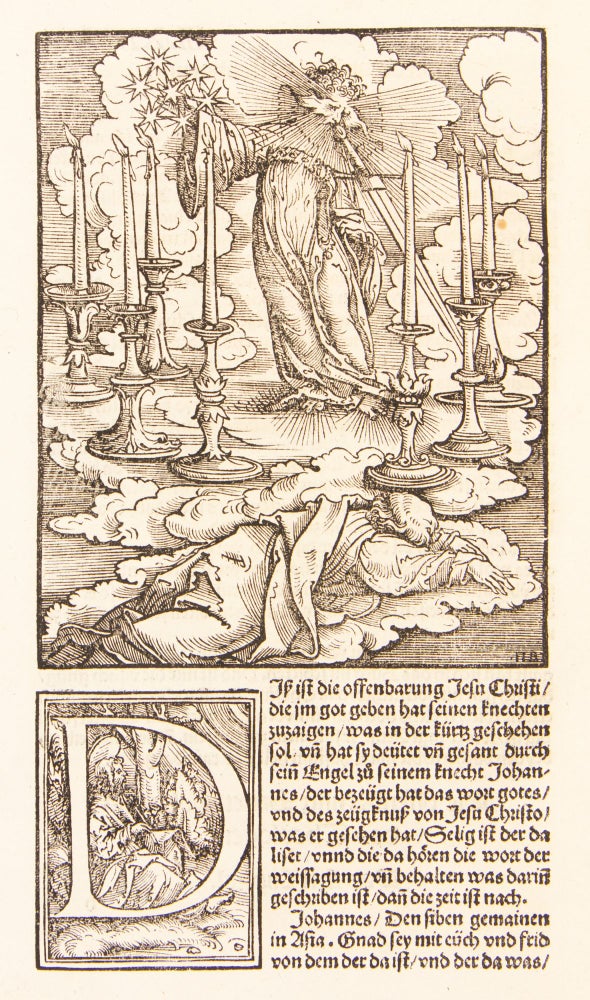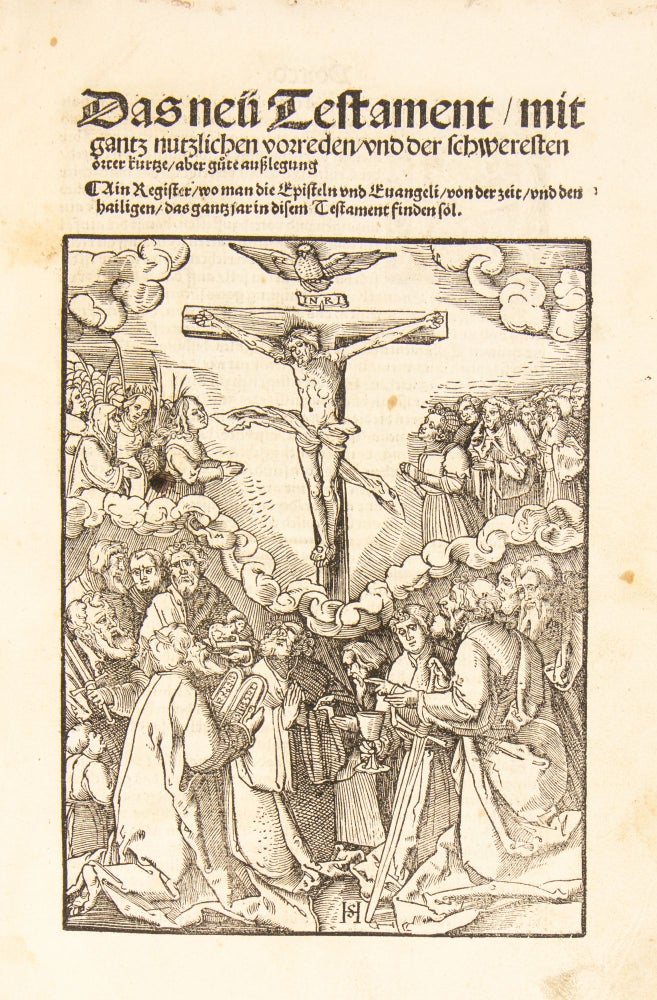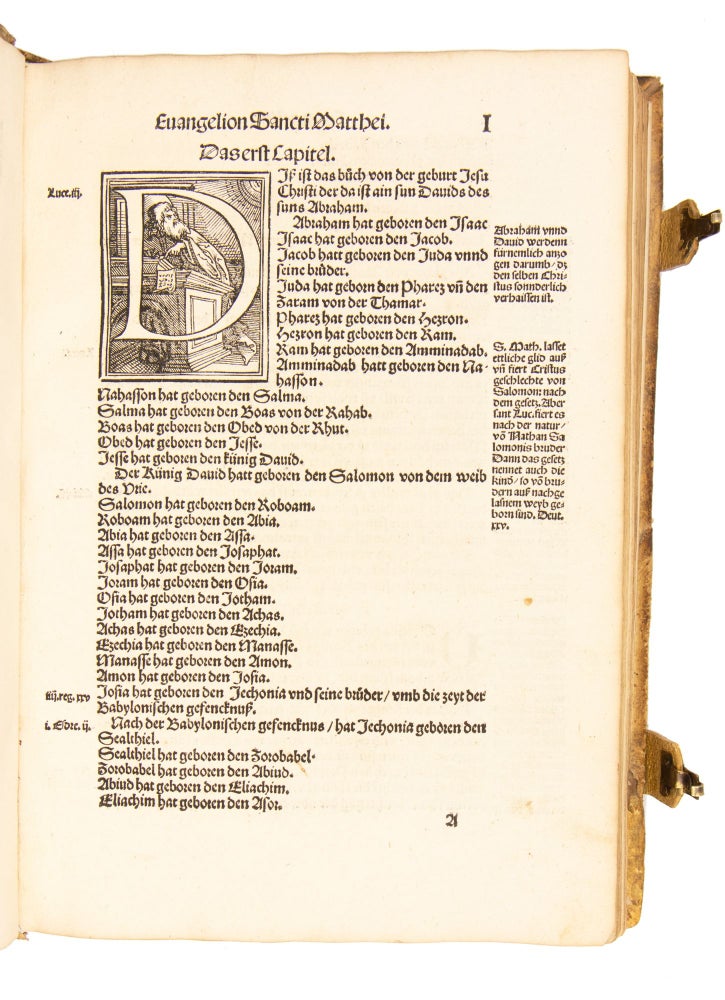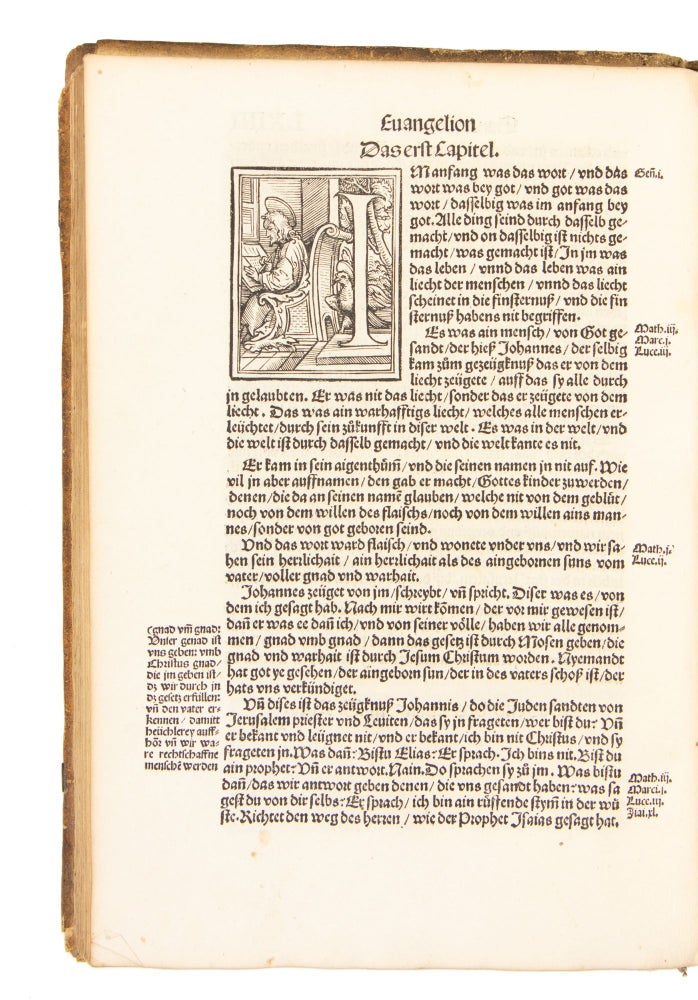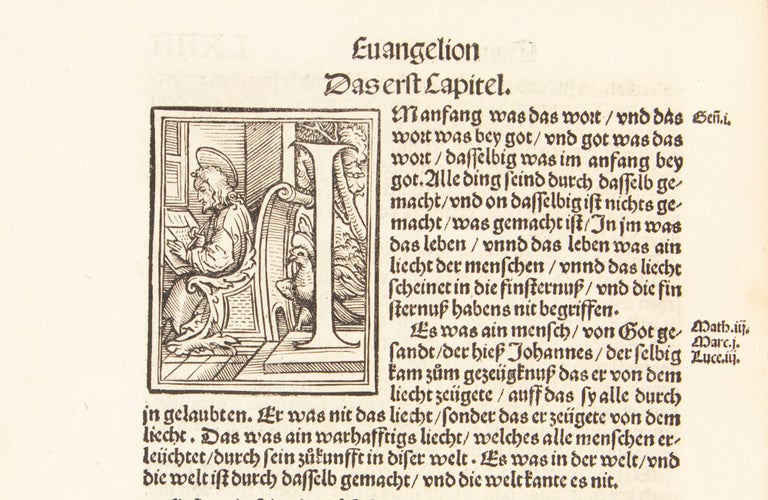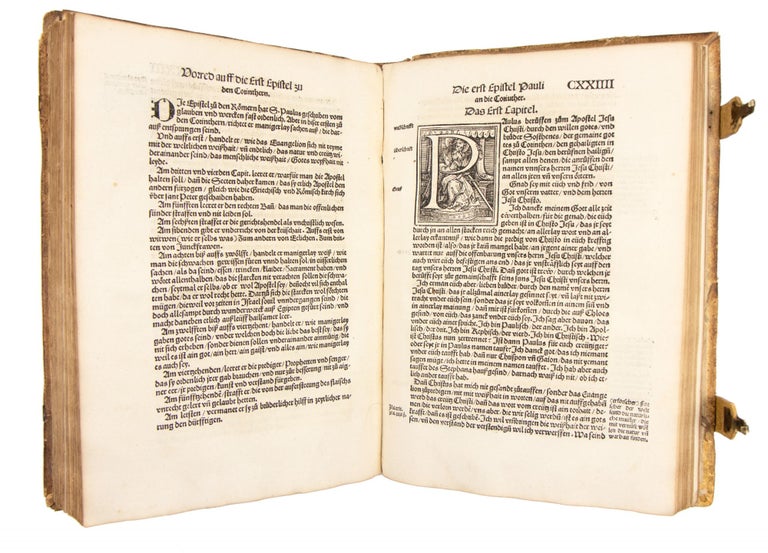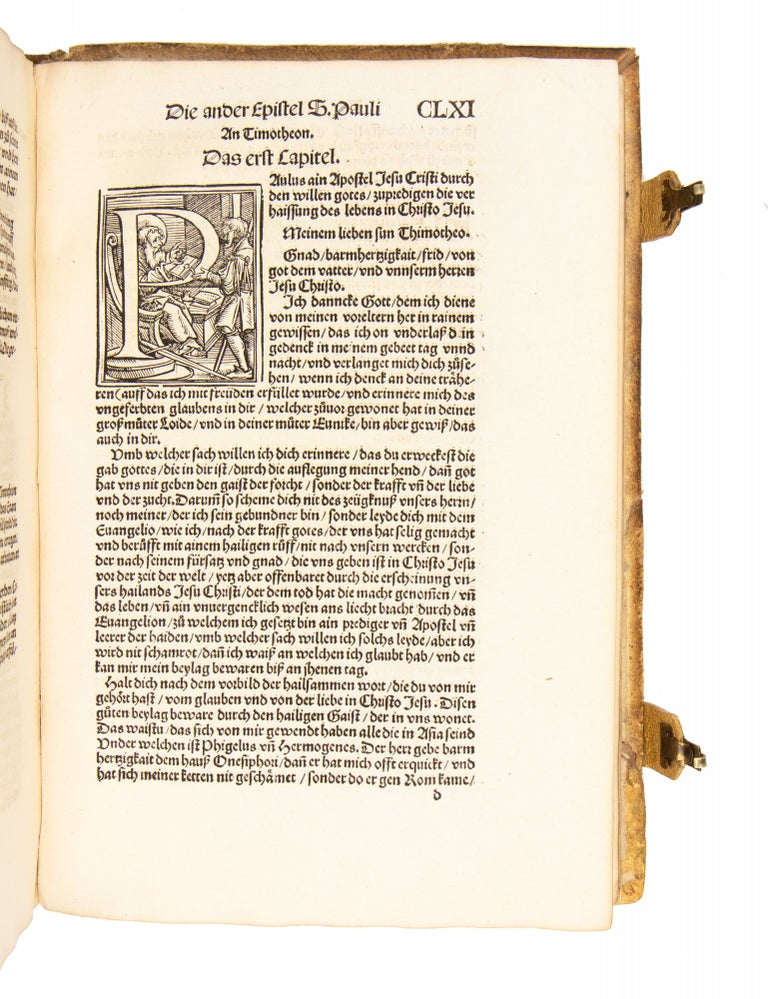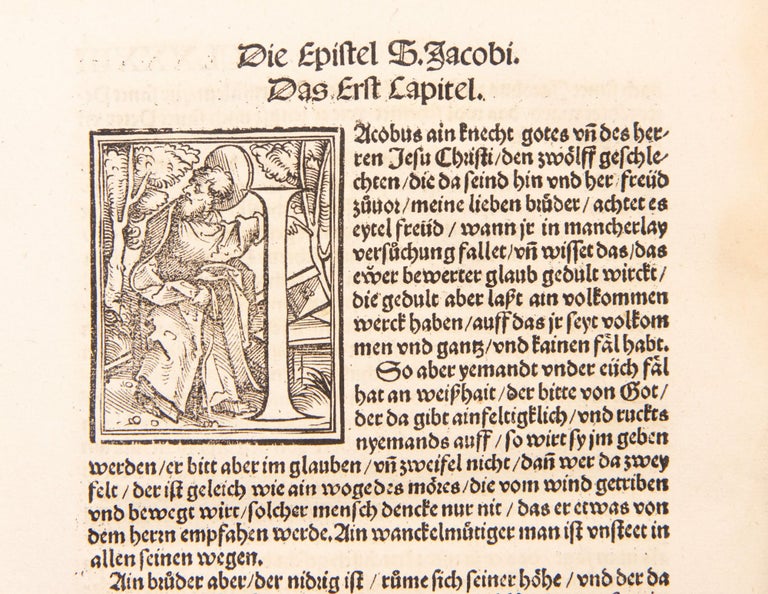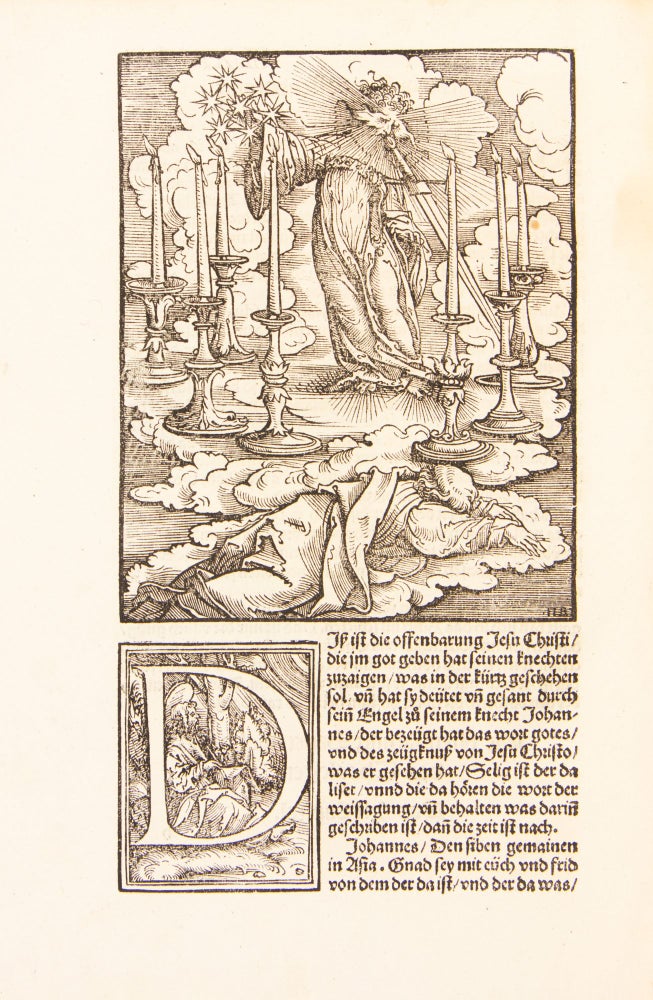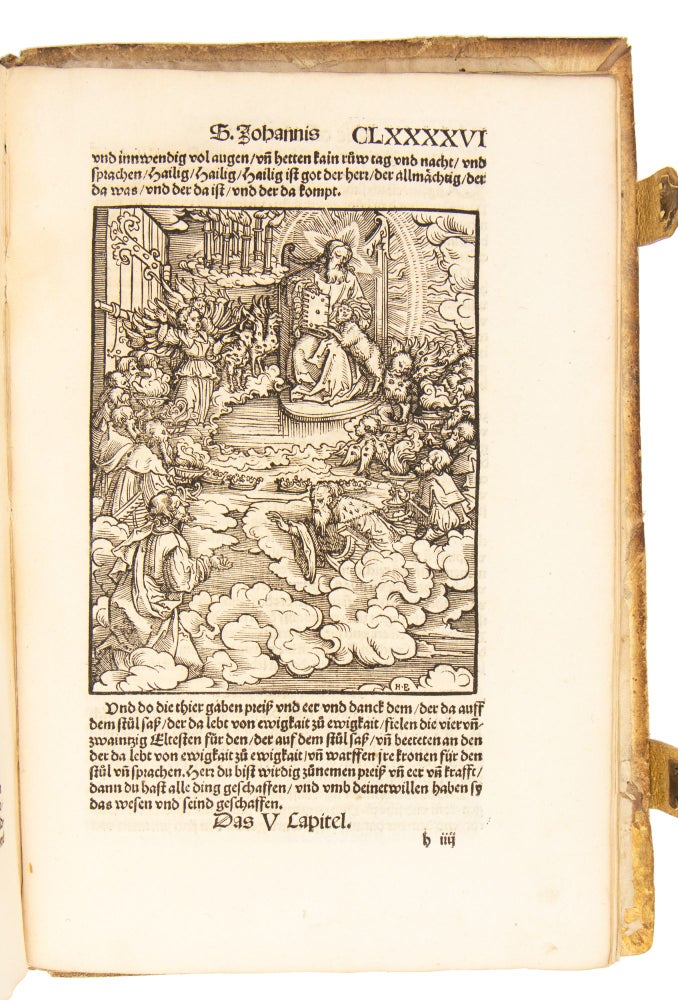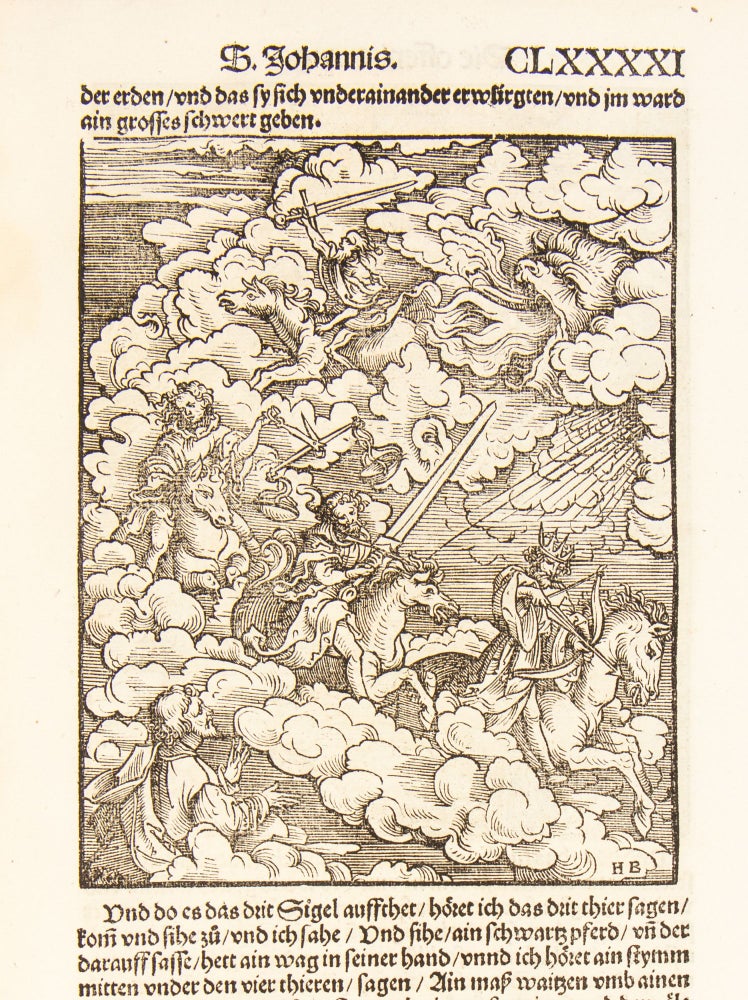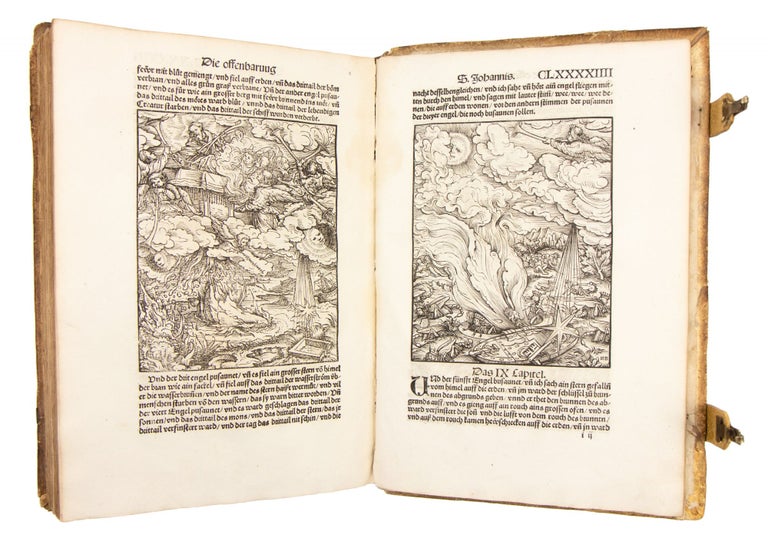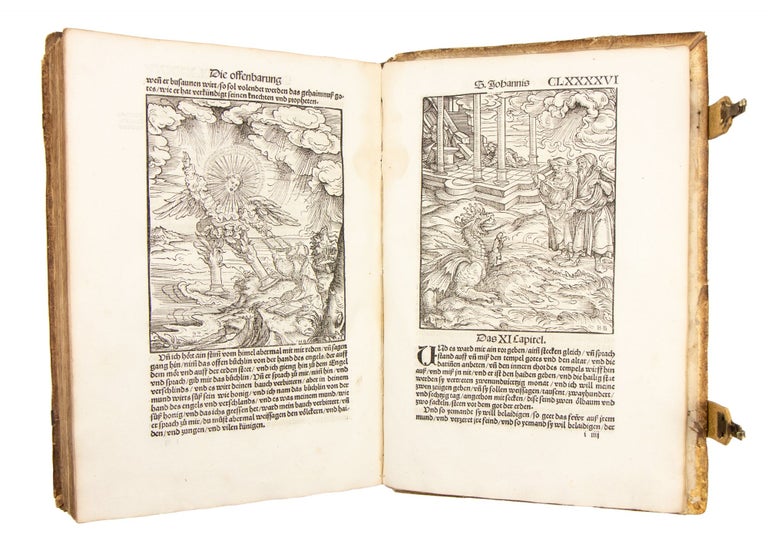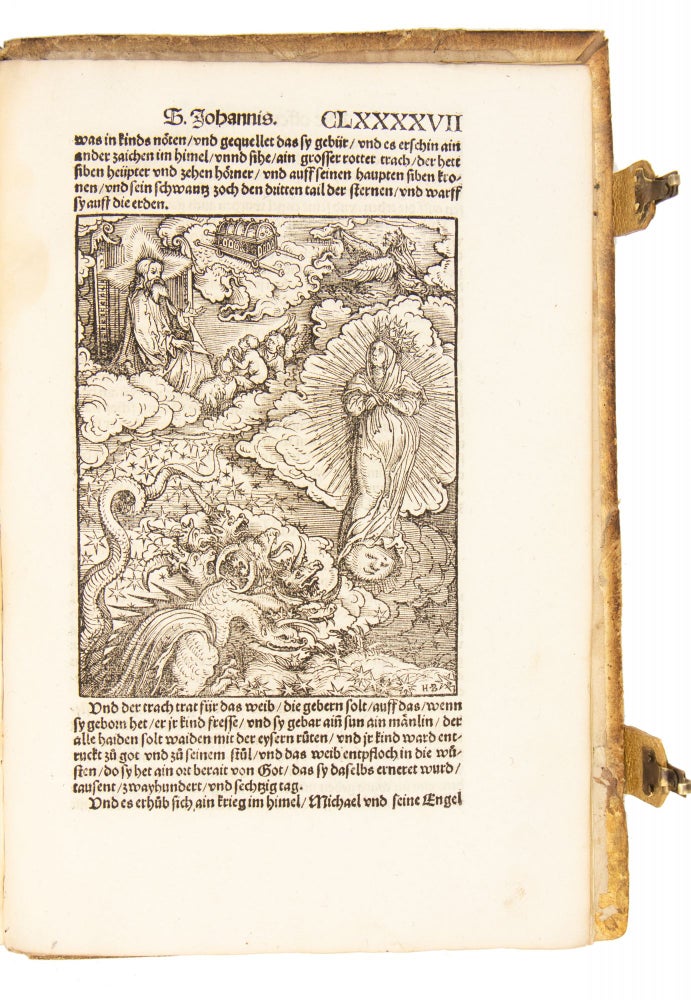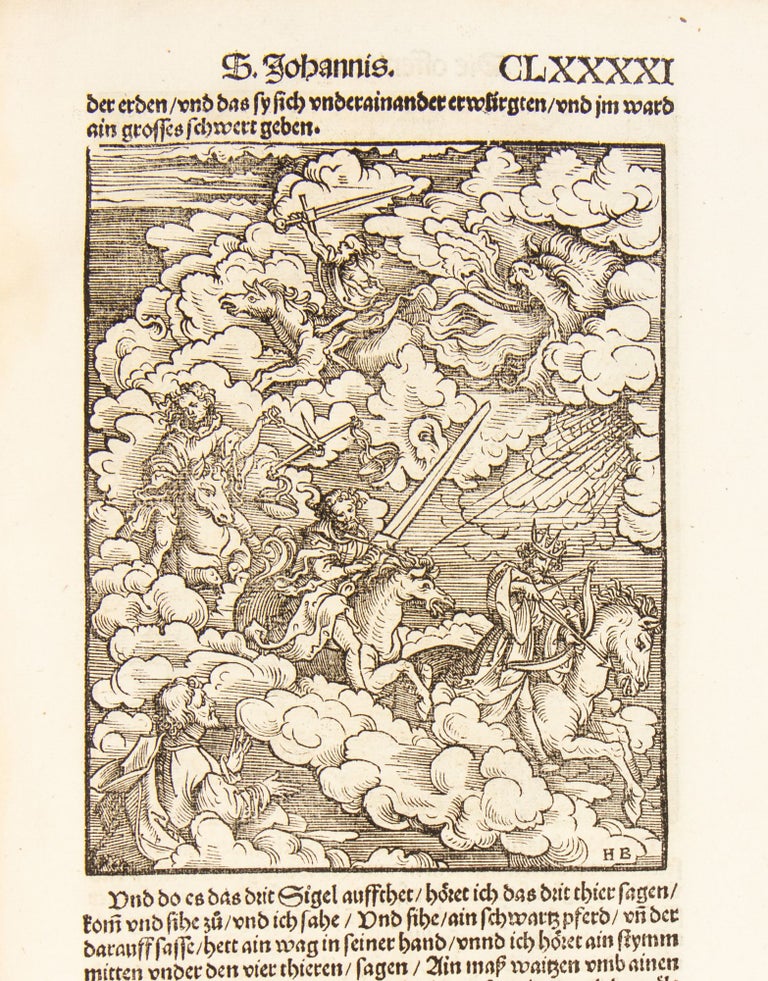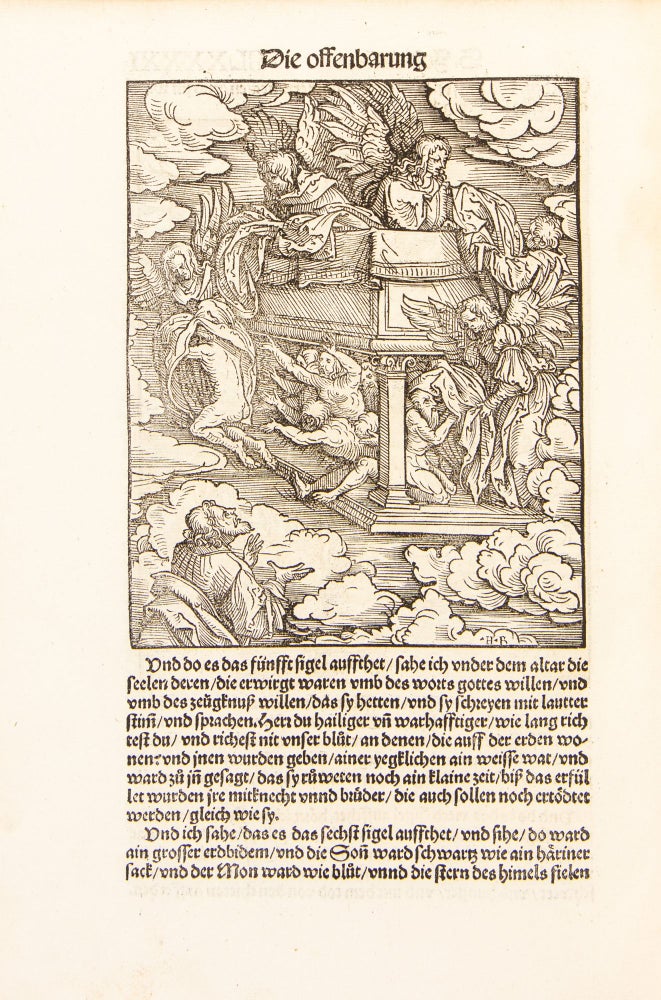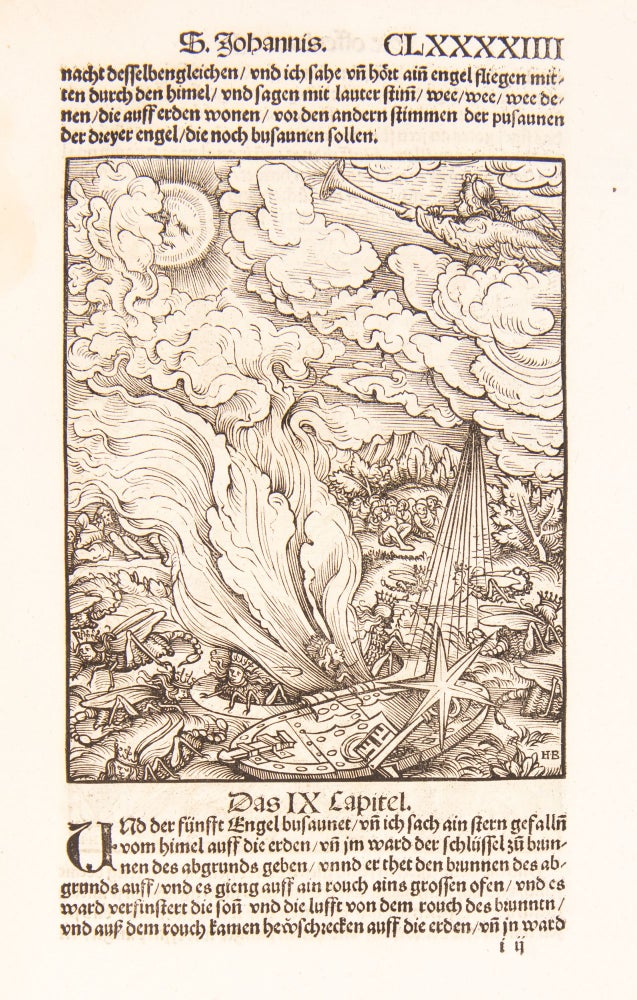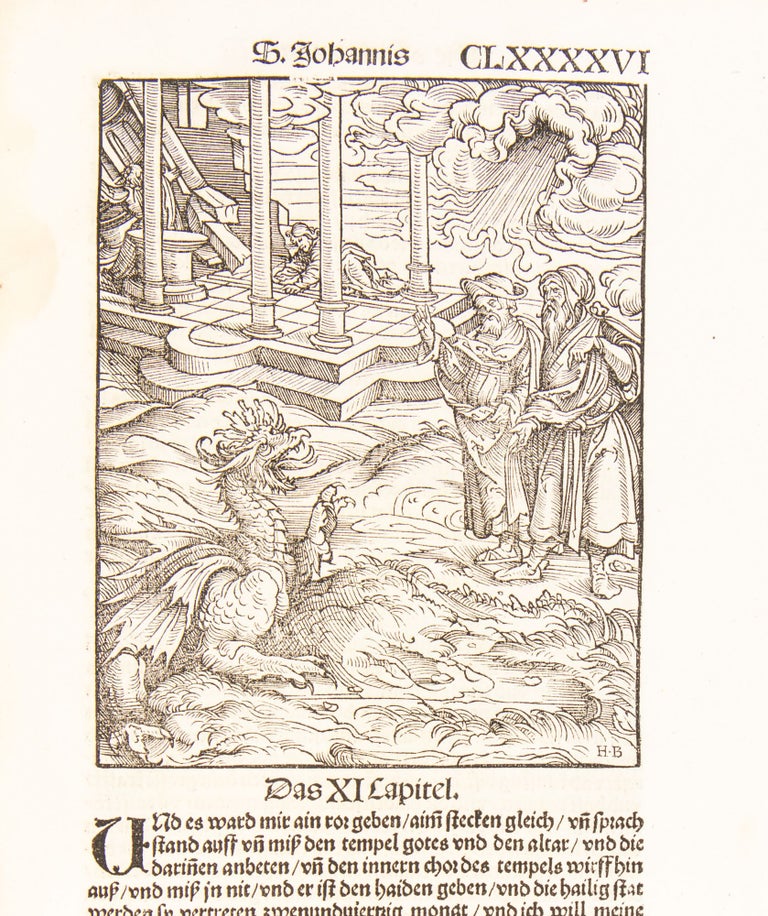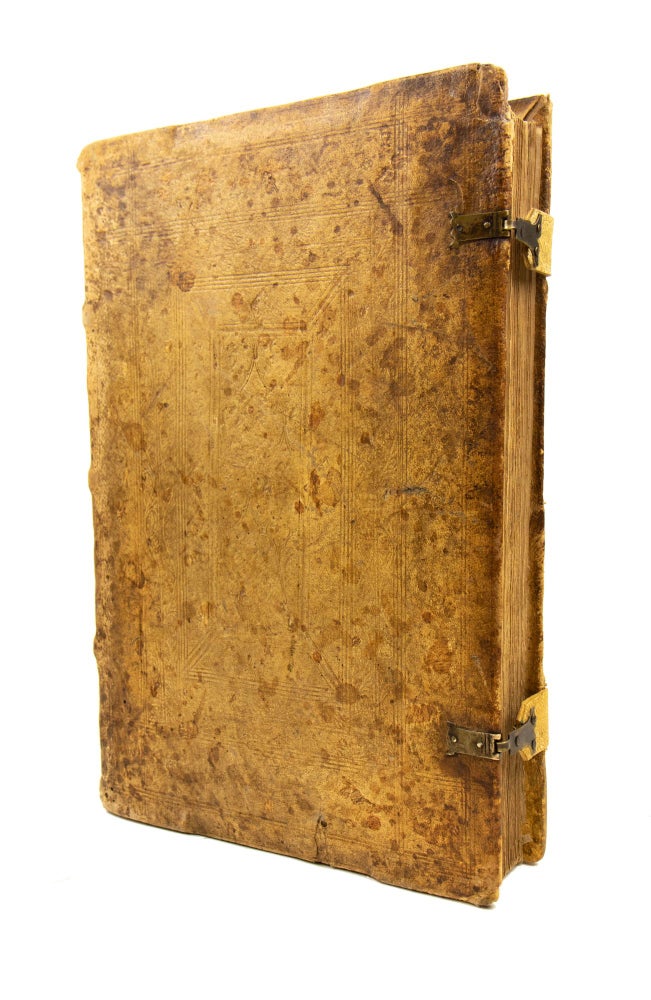Das neü Testament, mit gantz nutzlichen vorreden.
Augsburg: Silvan Otmar, 11 June, 1523.
Price: $125,000.00
Folio: 30 x 20.8 cm. [i-iiii]4, a-d4, A-N6, O4; P-Z6, a-f6, g8, h-i6, k8. Complete.
SECOND APPEARANCE OF HANS BURGKMAIR’S COMPLETE APOCALYPSE WOODCUT CYCLE.
A very early edition of Luther’s December Testament, appearing within six months of the first (Wittenberg, December 1522). With a large title woodcut by Hans Schäufelein, 25 large historiated woodcut initials (numerous repeats) with scenes of the Evangelists writing the Gospels, Paul writing the Epistles, and John writing the Book of Revelations. The Apocalypse is illustrated with 21 large woodcuts by Hans Burgkmair the Elder. The complete cycle first appeared less than three months earlier, in Otmar’s edition of 21 March.
With a large title woodcut by Hans Schäufelein, 25 large historiated woodcut initials (numerous repeats) with scenes of the Evangelists writing the Gospels, Paul writing the Epistles, and John writing the Book of Revelations. The Apocalypse is illustrated with 21 large woodcuts by Hans Burgkmair the Elder.
Bound in contemporary alum-tawed pigskin over beveled wooden boards (wear and stains to boards, extremities rubbed, corners bumped), ruled and tooled in blind, with original brass catches with the brass clasps restored. A fine, complete copy on bright paper, overall very fresh, with very minor faults: title lightly soiled and with a few small spots, occ. very mild damp-staining, a few closed tears, worm-trail in blank lower margin of opening signatures (not affecting the text) and in the blank inner margin of some later gatherings (occ. touching a letter or two).
Provenance: Front pastedown with 16th/17th cent. ownership inscription ("In usum H. Mem (m) ingk"), illustrated bookplates of the Kempten brewer Johann Leichtle (19th century) and his son, the landowner and collector Hans Leichtle, Castle Lenzfried in Kempten (ca. ca. 1927)
Working primarily from Erasmus’ second edition of the Greek text (1517), Martin Luther translated the New Testament into German in only eleven weeks, from mid-December 1521 to early March 1522, while in hiding in Wartburg Castle. Upon his return to Wittenberg, he revised the translation -with the assistance of Melanchthon. The first edition (the “September Testament”) was printed at Wittenberg by Melchior Lotter the Younger in September 1522. Its success was immediate and in December, Lotter printed a second edition (the “December Testament”), with Luther’s further revisions. Only the Book of Revelations was illustrated, with striking woodcuts by Lucas Cranach the Elder (1472–1553). Cranach was influenced in part by the Apocalypse of Albrecht Dürer (1498) but his woodcuts show a close reading of Luther’s text.
“In 1523 Luther’s German New Testament, with new illustrations for the Book of Revelations, was printed at Augsburg by Silvan Otmar. The images were created by Hans Burgkmair the Elder [one of the first German artists to show the influence of the Italian Renaissance]. Thematically they corresponded to those of the September Testament (by Lucas Cranach), but with a new, independent textual interpretation. Hans Burgkmair had read the Apocalypse carefully; his pictures are completely independent of those of Dürer… The images of the revelations are characterized by faithfulness to the text."(Schmidt, Lutherbibel)
“Although Martin Luther was not the first to translate the Bible into German, he was the first to translate the text from the original biblical languages. First printed at Wittenberg in September 1522, Luther’s German New Testament was considered a philological and literary masterpiece that exerted enormous influence on the development of modern German…
“In addition to aggressively promoting the reading of biblical texts in the vernacular, the Protestant Reformation also introduced one of the most creative and controversial periods of printed Bible illustration. Martin Luther made effective use of translations enriched with woodcuts, beginning with his first translation of the German New Testament, published by Melchior Lotter in Wittenberg in September, 1522, (the "September Bible".) For that edition he employed Lucas Cranach the Elder (1472–1553), one of the leading artists of the German Renaissance, to supply a rich program of woodcuts, including twenty-one full-page illustrations of the Apocalypse. Luther’s “December Testament” appeared with the same set of woodcuts used in the first edition.”(Martin Luther in The Age of Print, Bridwell Library)
“In 1523 and 1524, Hans Burgkmair the Elder (d. 1531) provided a [new] series of woodcuts used in several editions of Luther's New Testament printed by Silvan Otmar in Augsburg. Except for the first woodcut to the Apocalypse, which occupies a page by it self, the rest of the pictures, all nearly full-page size, are interspersed with the text. The initials "HB" may be noted in Burgkmair's woodcuts. These illustrations occasionally show a greater independence from Dürer than do those of Cranach in Luther's September Bible (1522), though both woodcutters undoubtedly had made use of Albrecht Dürer's work. Burgkmair frequently shows an interest in capturing the text quite literally. For instance, whereas Cranach follows Dürer in depicting the four horses and horsemen in battle line, Burgkmair has placed them in succession—which is, incidentally, truer to the text. Mention may be made of the three frogs coming out of the mouth of the dragon, beast, and false prophet in contrast to six frogs from the beast alone in the corresponding woodcut of the September Bible and of the sword proceeding from the mouth of the leader of the armies of heaven rather than just being held by him. It may also be noted that Burgkmair was less interested than Cranach in interpreting contemporary events through the woodcuts. Both of these artists, however, knew the Lutheran text of the New Testaments they were illustrating and endeavored to be true to it, as may be seen in the fact that whereas Dürer's woodcut for the first four trumpets depicts an eagle uttering the threefold ‘Woe,’ Cranach and Burgkmair pictured the cry as being given by an angel.”(Strand, Woodcuts to the Apocalypse in Durer's Time, p. 37)
The woodcuts:
Christ among the candlesticks (Rev. 1)
The throne, four living creatures, sealed book, and lamb (Rev. 4, 5)
The four horses and horsemen (Rev. 6:1-8)
Souls under the altar (Rev. 6:9-11)
Earthquake and signs in the sun, moon, and stars (Rev. 6:12-17)
The seal of God (Rev. 7:1-8)
The first four trumpets (Rev. 8:2-13)
The fifth trumpet (Rev. 9:1-11)
The sixth trumpet (Rev. 9:13-21)
The angel with the little book (Rev. 10)
The temple, two witnesses, and beast (Rev. 11:1-7)
The woman and great red dragon (Rev. 12)
The two beasts (Rev. 13)
The lamb on Mount Zion, the 144,000, and the three angels (Rev. 14:1-12)
The harvest (Rev. 14:14-20)
The seven last plagues (Rev. 15, 16)
The woman and the beast in the wilderness (Rev. 17)
The destruction of Babylon (Rev. 18)
The armies of heaven (Rev. 19:11-21)
The dragon thrown into the bottomless pit (Rev. 20:1-3)
The Holy City, New Jerusalem (Rev. 21).
VD 16, B 4322; Bibelsammlungen Württembergische Landesbibliothek, E 85; Muther p. 143, 892 and plates 176-177; Schmidt Lutherbibel, p. 128-133; Volz, illustrations 371 and 372; Zapf II, 164, XXI; Oldenbourg L 24 (Schäufelein)


